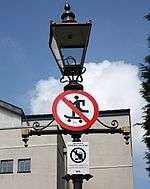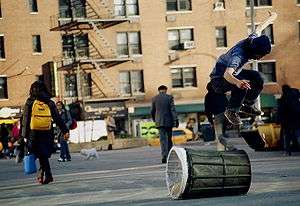Street skateboarding
Street skateboarding is a skateboarding discipline which focuses on flat land tricks, grinds, slides and aerials within urban environments and public spaces. Street skateboarders meet, skate and hang out, in and around urban areas referred to as "spots", which are commonly streets, plazas or industrial areas. To add variety and complexity to street skateboarding; obstacles such as handrails, stairs, walls, flower beds, bins, park benches, picnic tables and other street furniture[1] may be traversed as part of a single trick or a line (series of tricks.)
Clever and artistic uses of video and printed media have propelled Street Skateboarding to become the most widely accepted and participated form of Skateboarding in the modern world.
History
At the tail end of the 1980's and around the beginning of the 90's; street skateboarding evolved as a new approach to Skateboarding from elements taken from the other existing Skateboarding disciplines.[2] Instead of drained swimming pools and riding purpose-built skateparks, Skateboarders began to utilise urban areas and public spaces. A new style of skateboard deck (which had a kicktail at each end) became popular. Professional skateboarding became hyper commercialised and Skate Shops specialising in the retail of professional grade skateboarding equipment appeared in many cities across the world. Skate Shops in turn helped support a culture of Street Skateboarding by offering Skateboarders a refuge where they could check out and buy copies of the latest Skate Videos (VHS video tapes and then later DVDs), one of the few popular monthly magazine publications or other skateboard products.
The movement through urban areas evolved to where Skateboarders began riding within them exclusively; honing their skills by skating improvised courses made up of existing urban features.[3] As a result; street skaters observe architecture as part of a natural pursuit within a Metropolis to find new places and obstacles to skate.
Competitions
Competition level street skateboarding events are held within purpose-built skatepark arenas or cordoned off urban areas. Within a street skateboarding competition obstacle course, concrete, plastic or metal reproductions of obstacles naturally found within the urban environment are placed within adequate distance of each other utilising a natural style of positioning within the course. A course is usually complimented by adding transitions which permit greater travelling speed and an increased amount of "Air." Other forms of ramp such as funboxes which are designed with optimal space utilisation in mind are commonly found within a park's layout.
Modern Street Skateboarding competitions employ a format where each participant has two timed attempts or "runs" to attack the course and "shred" (perform a series of tricks as cleanly as possible.) The entrants attempts are then scored by a panel of judges to decide an overall winner. Competition entrants who perform exceptionally well are traditionally vocally congratulated and encouraged by the crowd during and at the end of their run. Spectating Skateboarders commonly show their appreciation for well performed tricks or smooth runs by slapping their skateboard on a hard surface or obstacle in a complimentary, often respectful but mostly audibly enthusiastic way.
A number of major international competitions include a street skateboarding event or component. Some examples:
- The X Games [4]
- Street League Skateboarding
- Maloof Money Cup
- Tampa Pro
- The 2020 Summer Olympic Games (For the very first time)
The plan to run a Skateboarding event at the 2020 Summer Olympics[5] in Japan has caused controversy within Skateboarding[6]. The widely held argument is based upon the ideology of what Skateboarding has evolved into and what Skateboarding means to the people who are responsible for shaping it into what it has become today.
The game of SKATE is a form of competition which requires no street obstacles and simply a perfectly smooth and sufficiently large skating surface for skateboarders to use to take it in turns to attempt to land flat land tricks.
Technical set up
Street Skateboards are built using individual professional grade component parts which are sold by specialist Skateboard retailers. A part of the revolution of Street Skateboarding was the transition of the Skate industry into the hands of Skateboarders, who would design, manufacture and retail the products themselves. This removed the skate industry from the hands of venture capitalists who had created a monopoly in the 1980s. The industry has since gone full circle, with many grass root companies founded in the 90's now sold to venture capitalist groups and enterprises. However, there are still a number of Skateboarder owned companies manufacturing skateboard products today.
The most common specifications of a modern professional grade skateboard suitable for street competition and practice are as follows:
- 52mm wide 99A durameter wheels (four in total)
- A pair of low in height 7.6" wide trucks
- A 7.75" wide professional grade 7 ply Canadian maple deck
- 8 bearings
- 8 nuts and bolts
- A sheet of Griptape
There is no specific standard which should be followed when constructing a skateboard from parts. The consensus is that the board should just "feel right" once assembled after a few rides. Fully built setups are available to buy at Skate Shops and often provide excellent value for riders new to skateboarding.
The technical specifications of specific component parts of a skateboard designed for street skateboarding vary from rider to rider and depend upon the following factors:
- Rider height
- Rider weight
- Shoe size
- Skill level
- Comfort
- Budget
- Preferred terrain, obstacles and style of skating
For example: A rider is small in stature and foot size, so therefore selects a deck which is 7 1/2 inches wide and a set of trucks which match the width of the deck. Riders new to Street Skateboarding benefit greatly by seeking out advice regarding equipment from local skate parks and shops.
Wheels come in sizes between 48 mm and 62 mm and decks can be as narrow in width as 7.5" or as wide as 8.75" and 760 to 830 millimetres (30 to 33 in) in length. Wheels are made of polyurethane, with a hardness (durometer) anywhere above 80A. Some wheels will be made harder than measurable on the "A" scale and will have durometers of up to 84B (about 104A.) Wheel sizes are relatively small so that the roll speed is as fast as possible and the complete setup is also light. This can make technical tricks easier to practice and perform. Board shapes have changed considerably since the 1970s but modern pro models have remained similar in shape since the invention of the concave double kicktail deck. The contemporary shape of the skateboard is derived from the freestyle boards of the 1980s with a largely symmetrical shape and relatively narrow width.[7][8][9] Parts can be individually replaced and fixed should they require maintenance.[10]
Skateboard shoes are an important piece of street skateboarding equipment. Modern professional grade skate shoes evolved in part due to the increase in durability required as a result of the abrasion which constant practice causes to footwear materials. Innovations such as footwear technology[11] which attempts to reduce the risk of heel bruises, increases "board feel" and improves durability have improved not only skate shoes but modern footwear in general.
Street skateboarders often travel with a block of wax which is rubbed onto masonry to prepare it before a trick is attempted. The wax helps reduce the friction between the surfaces of the two materials when tricks which involve grinding or sliding are attempted.
Interaction with the general public

Because Skateboarders make use of urban environments and public spaces, public officials have often and continue to, exhibit self serving, aggressive and antisocial attitudes and policies in their pursuit of the prohibition of street skateboarding. Law enforcement officers, security guards and other figures of authority consistently demonstrate that they will not tolerate public spaces being used in ways which do not support their own or their employer's world view and beliefs. The problem involves a consistent amount of disrespect demonstrated by officials who perceive the issue as an adult versus child discussion, rather than that of a public spaces and recreational problem. This is because the majority of Skateboarders are young people. While authority figures are not.
There are instances where local authorities in popular skateboarding areas have introduced initiatives which ban skateboarding, confiscate skateboards, or make skateboarding difficult or impossible by adding anti-skate devices to the environment.[12]
References
- ↑ Foster, Philip (29 April 2012). "Different Kinds of Skateboarding". LiveStrong. Retrieved 6 April 2013.
- ↑ The Man Who Souled the World at IMDB
- ↑ Goodfellow, Evan; Werner, Doug (1 June 2005). Street Skateboarding: Endless Grinds and Slides. Tracks Publishing.
- ↑ Fleming, Robin (18 June 2012). "Skills to Pay the Bills". ESPN X Games. Retrieved 6 April 2013.
- ↑ "GOING OLYMPIC: TOKYO 2020 – OLYMPIC CHANNEL LOOKS AT THE FIVE NEW SPORTS ON THE PROGRAMME". olympic.org. Retrieved 25 July 2018.
- ↑ "Skating in the Olympics: The Skaters' Perspective". Thrasher Magazine. Retrieved 25 July 2018.
- ↑ "Freestyle". Skateboard Express. Retrieved 6 April 2013.
- ↑ "How Boards Have Changed Over Time". Exploratorium. Retrieved 6 April 2013.
- ↑ "Skateboard Guide and Skate Size Chart". evo. Retrieved 6 April 2013.
- ↑ "Maintenance Guide". Vault Skate. Retrieved 6 April 2013.
- ↑ "Skateboarding starts with es". Sole Technology. Retrieved 25 July 2018.
- ↑ "Skateboarders unfairly labeled". Martinsville Bulletin. 4 February 2013. Retrieved 6 April 2013.
